Hello?
Today, I'm going to talk about the dangers of an ultrasound scan, especially a fetal ultrasound scan during pregnancy. It may be difficult, but I hope that it will help not only the mother but also the obstetricians.
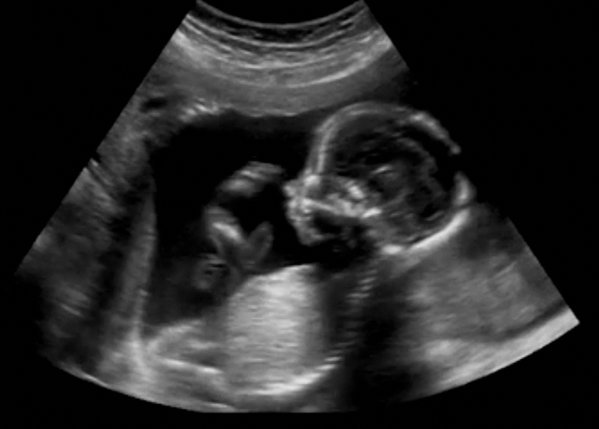
Is a fetal ultrasound scan safe?
The Principle of Ultrasound

First, let's look at the principle of ultrasound.
Ultrasound is a sound wave with a frequency that exceeds the audible frequency (16-20000 Hz). Usually, 2-15 MHz is used in the medical field. Ultrasonic waves generated from the probe (the object touching patients) are absorbed, reflected and scattered while passing through the human tissue. The reflected sound waves are picked up by the probe and expressed as dots on the screen. A lot of reflected sound waves form the ultrasound screen.
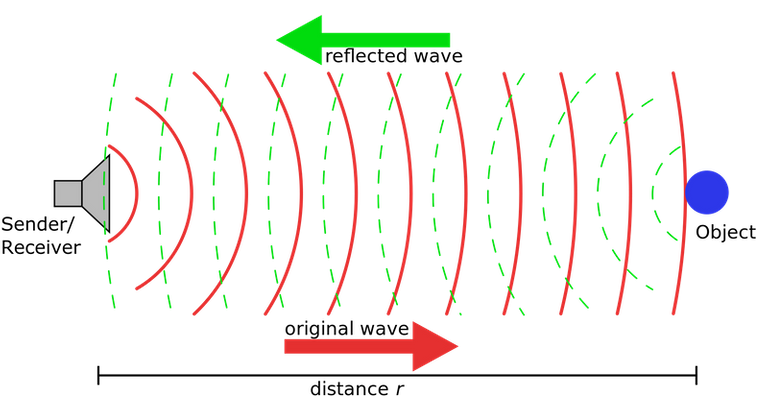
The principle of Ultrasound. The reflected sound waves are read and displayed on the screen.
Biological effects of ultrasound
Because ultrasound passes through human tissues, it can alsoaffect human tissues. There is no clear evidence for whether these effects are still harmful to the human body. The effects on the human body are mainly divided into 'thermal effects' and 'non-thermal effects'.
Thermal effects
When a ultrasonic wave from the probe is absorbed into tissues, its energy is converted to heat. This ultrasonic energy causes a local temperature rise. The degree of temperature rise is related to frequency, intensity, range, duration, and removal rate of blood flow. In an animal experiment, it is said that there is possibility of danger, if there is an increase of more than 4 degrees for 5 minutes in the fetus from ultrasound heat. Especially, high fever can affect the vulnerable central nervous system (brain, and spinal cord) and cause neural tube defects or growth restriction. Heat also affects placenta and uterine activity, which can cause abortion.
However, it is unclear that ultrasound-induced heat threatens the actual human fetus. A slight temperature rise (less than 1.5 degrees) does not harm human fetus, regardless of duration.
Non-thermal effects
The non-thermal effect is in other words the mechanical effect.
One is the cavitation effect. This is a phenomenon that gas bubbles occur in body fluids or in empty spaces. Experimentally when bubbles expand, they can cause high temperatures and pressures, resulting in harmful reactive oxygen species and damage to DNA. It can also cause physical cell membranes breakdown or cell breakdown while vibrating (bubble). However, these results are all found only in the experiment and may occur when using ultrasound contrast agent, which is rarely used in maternal ultrasound.
The other is acoustic streaming and torque. This is the force applied to the tissue when the ultrasound is spreading. This force causes damage or decomposition of the cells. However, it is also known experimentally and rarely occurs in actual diagnostic ultrasound.
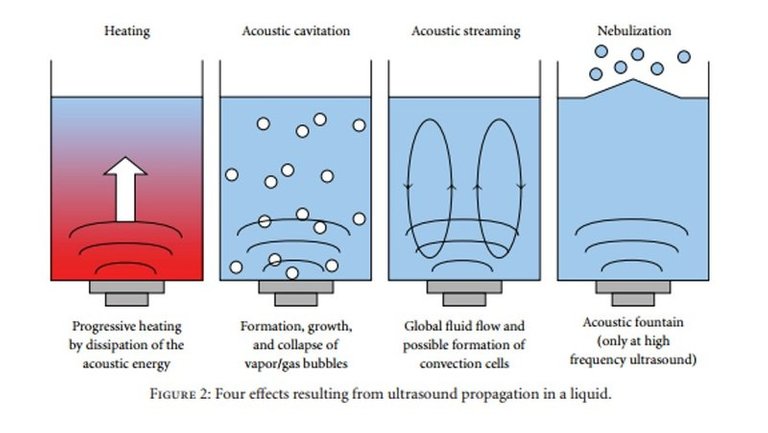
Four effects of ultrasound on liquids. The three effects from the left are mainly mentioned in biological effects.
Ultrasound risk assessment
TI (Thermal index)
Although the risk due to the thermal effects of ultrasound is not clear, there is a way to evaluate it. If you look at the ultrasound screen, there is an item called TI and it is the answer. It means the maximum elevation of the temperature that can occur in tissues exposed to ultrasound (TI=1 means a maximum temperature increase of 1 degree). With this TI, the doctor can assume how much the heat effect is and stop the ultrasound properly.
By the way, there are two types of TI. You should consider a thermal index for soft tissue (TIS) before 10 weeks and a thermal index for bone (TIB) after 10 weeks of pregnancy. The reason for this is that TIS, which is based on soft tissues, has to be considered before 10 weeks of pregnancy because the fetal bones are not formed. TIB should be considered after bones are formed, over 10 weeks of pregnancy. The reason is that the transverse shear wave on the surface of the bone makes a lot of contribution to the heat of surrounding tissues. According to the guideline presented in the UK, a TI of 0.7 or less is safe, and between 0.7 and 3.0, time must be taken care of. If it is higher than 3.0, it should not be performed.
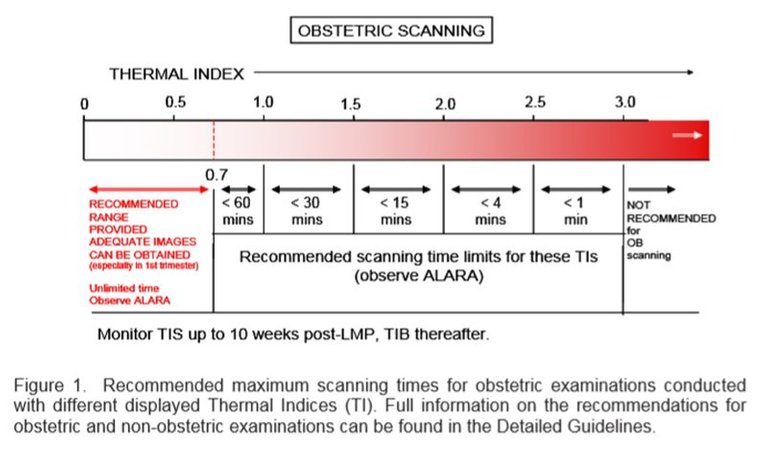
The guidelines of UK. Less than 0.7 is safe, more than 3.0 is dangerous.
MI (Mechanical Index)
Non-thermal effect is not known to affect the fetus until now, but can be evaluated by MI. This is the peak negative pressure of the ultrasound wave divided by the square root of the frequency. According to UK guidelines, fetal ultrasound scan is recommended to be performed at 0.7 or less, when ultrasound contrast agents are used. It means there will not have a major impact on normal fetal ultrasound (because ultrasound contrast agents are rarely used in routine fetal ultrasound scan). Rather, it is recommended that the ultrasound scan of newborn infant should be performed at 0.3 or less.
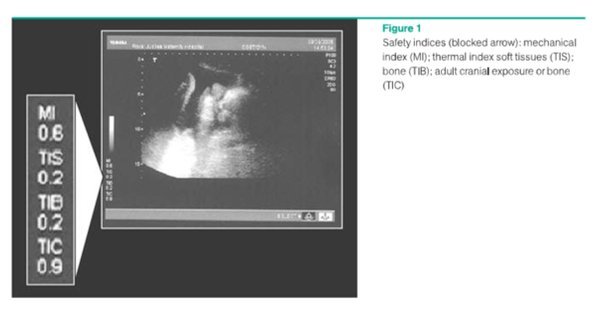
If you look closely, you can see TI and MI on the ultrasound screen.
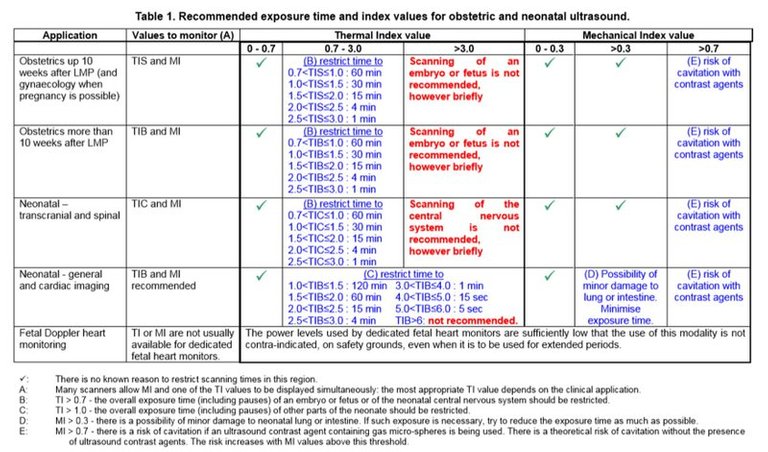
Guidelines for TI and MI in the UK.
3D or non-medical ultrasound
3D ultrasound for diagnostic purposes is very helpful for diagnosing fetal malformations. However, for non-medical purposes or for memorial purposes, you may occasionally take or store ultrasound images. The US and UK Ultrasound Society do not recommend this.
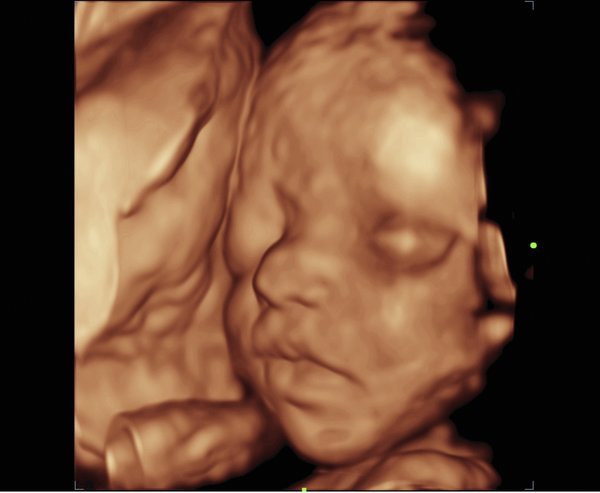
An ultrasound scan just for memorial purpose, it is NOT recommended.
Other things to note for obstetricians
It is important to see TI and MI, but there are also other important things.
- Reduce power settings.
- Make ultrasound scanning time as short as possible.
- Do not fix the probe too tightly in one place.
- Do not use if the probe (esp. trans-vaginal or trans-rectal US) which is self-heated before the scan.
- Do not perform the Doppler ultrasound to heat-sensitive tissues (fetus before 10 weeks/head, spine, and eyes of fetus or newborn).
To conclude
Until now, there is no clear evidence that ultrasound is harmful to a fetus. So, ultrasound is one of the safest tests, and there is no reason to worry about safety. However, it is necessary to be careful enough because ultrasound can cause harm to the fetal tissue by the thermal effect or the heat effect experimentally.
A obstetrician who performs a fetal ultrasound scan should take a careful look at TI and MI(BUT rarely elevated..) and follow the guidelines. As like radiation expose, it would be important to avoid non-medical examinations, and to scan as little as necessary -> ALARA principle; As Low As Reasonably Achievable!!.
.jpg)
An ultrasound scan is safe. But let's keep the guidelines!
Reference
- https://www.fda.gov
- http://www.wfumb.org/safety-statements/
- The British Medical Ultrasound Society. Guidelines for the safe use of diagnostic ultrasound equipment.
- The American Institute of Ultrasound in Medicine, AIUM Practice Parameter for the Performance of Obstetric Ultrasound Examinations. 2013.
- Jolly Joy et al. Review: Is ultrasound safe?. The Ostetrician & Gynaecologist 2006;8;222-227.
- Mathieu Legay et al. Enhancement of Heat Transfer by Ultrasound: Review and Recent Advances. International Journal of Chemical Engineering 2011; Volume 2011, 17 pages.
- [Korean] 박중신. 초음파 검사는 태아에게 유해한가?. J Korean Med Assoc 2008;51(9);823-830.
- Images without source; from Shutterstock.

This work is licensed under the Creative Commons Attribution-Noncommercial-NoDerivatives 4.0 International License.


Buen articulo ceñido a la realidad científica,espero leer mas, soy medico ecografista en San Casimiro Aragua Venezuela.Saludos tienes mi voto
Gracias, but I can't speak Spanish ;(
I keep trying to write good article :)